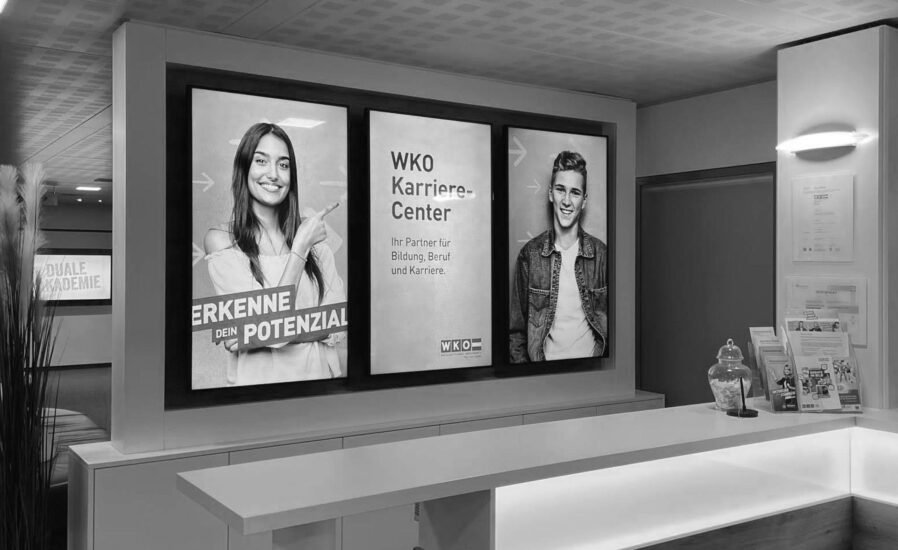
In today’s fast-paced, tech-driven world, traditional forms of advertising such as printed billboards and posters are gradually making way for digital signage. But what exactly is digital signage, and why has it become so popular across various industries?
In simple terms, digital signage refers to the use of digital displays to deliver dynamic content, advertisements, announcements, or information. These displays can range from large outdoor LED screens to smaller indoor monitors, and they are powered by digital content management systems that allow businesses and organizations to manage and update their messages in real-time.
In this blog post, we’ll explore what digital signage is, how it works, and why it’s quickly becoming an essential tool for businesses, educational institutions, and public spaces alike.
What Does Digital Signage Include?
Digital signage encompasses a broad spectrum of technologies that allow content to be displayed electronically, as opposed to using traditional static media. It includes:
- Digital Displays: These can be LED, LCD, or OLED screens that display content ranging from videos and images to social media feeds and interactive applications.
- Content Management System (CMS): A software platform that allows users to create, schedule, and control the content displayed on digital screens.
- Media Players: These devices play the content stored or streamed from a central server to the displays.
- Connectivity: Most digital signage setups use internet connectivity, allowing content to be updated remotely or in real-time.
This combination of hardware and software makes digital signage a powerful tool for delivering targeted, engaging, and timely content to audiences.
How Does Digital Signage Work?
At its core, digital signage works through the integration of digital displays, media players, and a content management system (CMS). Here’s how the process typically works:
- Content Creation: The content, whether it’s an advertisement, news, or informational display, is created and formatted through a software platform (CMS).
- Content Scheduling: Once the content is ready, it’s scheduled for display. This allows businesses to control when and where specific content appears, tailoring it to the audience’s needs and time of day.
- Content Distribution: The CMS sends the content to media players connected to the digital screens, either via the internet or a local network.
- Display: The media players render and display the content on the screens. Depending on the setup, the screens can show static images, video, live data, or even interactive content.
The flexibility of this system is what makes digital signage so valuable—it allows businesses to manage multiple screens, update content remotely, and provide real-time information, all in one seamless process.
Types of Digital Signage
Digital signage comes in many forms, depending on its use and location. Some of the most common types include:
1. Outdoor Digital Signage
Outdoor digital signage typically features large, weather-resistant displays that are visible in all types of lighting conditions. These screens are ideal for advertising and providing real-time information in high-traffic areas such as billboards, train stations, and airports.
2. Indoor Digital Signage
Indoor digital signage is used in places like shopping malls, corporate offices, restaurants, and schools. These screens provide targeted content, promotions, or updates in a controlled environment. Indoor signage can be interactive or passive depending on the needs of the space.
3. Interactive Digital Signage
Interactive digital signage allows users to engage with the display through touch, motion sensors, or voice commands. These systems are popular in retail environments, museums, and events where engagement is key.
4. Video Walls
A video wall is a larger version of digital signage, made up of multiple screens that work together to create one seamless, high-resolution display. Video walls are often used for advertising in large public spaces, control rooms, or stadiums.
5. Digital Menu Boards
Restaurants and cafes use digital menu boards to display menu items and promotions in an easy-to-read, dynamic format. These can be updated instantly, allowing businesses to promote daily specials or limited-time offers.
Benefits of Digital Signage
Digital signage offers numerous benefits over traditional forms of advertising and communication. Here are just a few of the reasons why businesses and organizations are increasingly turning to digital signage:
1. Enhanced Engagement
Digital signage captures the attention of customers more effectively than static displays. The use of moving images, videos, and real-time updates increases viewer engagement, making it more likely that the audience will remember the message.
2. Flexibility and Real-Time Updates
One of the biggest advantages of digital signage is its flexibility. Content can be easily updated in real-time, allowing businesses to adjust their messaging based on the time of day, promotions, or current events. For example, a retail store could update digital displays to feature new arrivals or discounts without needing to print new posters.
3. Cost-Effectiveness
While the initial investment in digital signage can be higher compared to traditional signage, the long-term savings are substantial. Digital signage eliminates the need for printing and physically replacing posters, making it more cost-effective over time.
4. Targeted Content
Digital signage enables businesses to deliver highly targeted content. For example, a clothing store could display different advertisements depending on the season or the demographic of the customer in the store at that time. This level of personalization helps improve the effectiveness of marketing efforts.
5. Real-Time Communication
In public spaces like airports, malls, and office buildings, digital signage can be used to provide real-time updates on schedules, news, weather, and emergencies. This improves communication and ensures that visitors or employees are always up-to-date.
6. Brand Consistency
Digital signage ensures that your messaging is consistent across multiple locations or displays. Whether you’re running a national campaign or updating local promotions, digital signage helps maintain brand integrity and message consistency.
Applications of Digital Signage
The versatility of digital signage means that it can be applied across many industries and settings. Some of the most common applications include:
- Retail: Displaying promotions, advertisements, product information, or store directories.
- Corporate: Facilitating internal communication, showcasing company news, or displaying live data dashboards.
- Education: Offering interactive learning opportunities, campus announcements, or event calendars.
- Healthcare: Displaying patient information, waiting room entertainment, or health tips.
- Transportation: Providing real-time schedules, alerts, and directions in airports, train stations, or bus terminals.
Conclusion
Digital signage has become an indispensable tool for businesses, institutions, and organizations looking to engage their audiences in dynamic and impactful ways. From retail stores to corporate offices, the ability to display real-time content and manage multiple screens from a single location makes digital signage a powerful communication tool.
Whether you’re looking to enhance customer engagement, improve internal communication, or create immersive experiences, digital signage offers an efficient and effective solution to meet your needs.
Last modified: November 18, 2024



